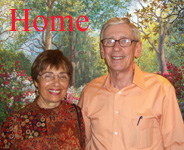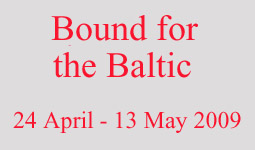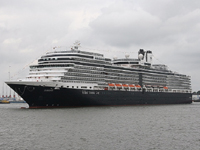Page 1 2 3 4 5 6 7 8 9 10 11 12 Sunday, 3 May. We lost another hour at 2:00 a.m. but this was another day "at sea" so it was more tolerable. We ordered breakfast in our room and it was delivered 15 minutes after the half hour window specified in our request. That was no problem because we didn't have to be to our first lecture until 10:00 a.m. The day was cloudy and cooler (60 degree high), and there was a small gale with six foot swells. We went to two morning lectures and one in the afternoon. At the formal dinner that evening, by the oddest coincidence we were seated with Lou and Shirley Ceci. Lou was in my Marquette Law School class (1954) and later served 17 years as a justice on the Wisconsin Supreme Court. After dinner we attended the 9:00 show featuring Brenda Cochrane, a Scottish singer with an operatic voice. Monday, 4 May. We entered the estuary of the Tagus River about 1:30 p.m. The day was sunny and warm with a high later of 80 degrees. It was a beautiful approach to Lisbon as we passed the Belem Tower, the Monument to the Discoveries, and the Jeronimos Monastery.
The Jeronimos Monastery is the oldest of these three monuments to the Age of Discovery, though just barely. The existing structure was begun in 1502 to commemorate Vasco da Gama's successful return from India in 1499, and it was completed 50 years later. The Belem Tower (early 16th century), was also built to commemorate da Gama's expedition. The Monument to the Discoveries was inaugurated in 1960 on the 500th anniversary of the death of Prince Henry the Navigator.
As we continued up the Tagus, we passed the Cristo Rei
(Christ the King) statue (1959) high above the 25th of April suspension
bridge. The statue was inspired by
the Christ the Redeemer statue above Rio de Janeiro. The bridge is
impressive in size and has two decks, one for cars and trucks (1966), the
other for trains (1999). It was built by the same company that built the
Golden Gate Bridge in San Francisco.
The ship docked near the bridge at about 2:00. That was well north of central Lisbon. Jane and I had been to Lisbon for a couple days as part of a tour in April 1972 while stationed with the Army in Heidelberg. We remembered a little about the city center and the old Alfama section but, with the ship docked so far to the north, nothing was familiar here. We left the ship soon after it docked, planning a quick visit to Alfama. We soon realized that we were poorly prepared for Lisbon. We had no information about transportation into the city. The ship's excursion director had spoken of "merchant vans" that usually met the ship and took passengers into the city center, but no such vans were there. There were no regular taxis either, only a few whose drivers declared themselves English-speaking guides, prepared to conduct multi-hour guided tours for a hefty price. There were also "hop on, hop off" buses that we learned later from those who took them were a complete disaster. Figuring someone must know what they were doing, we followed the crowd to a nearby train station. After struggling a long time with the automatic ticket dispenser, we finally caught a train heading for Lisbon. However, the train only went to Cais do Sodre, still some distance from downtown, at which point you had to take a taxi or walk to a subway station to go the rest of the way. As we were walking out of the train station at Cais do Sodre, two young women asked Jane if we would share a cab into the city center, and she agreed. We found a taxi stand outside the station with one cab waiting. One of the girls quickly got into the back seat and began to haggle with the driver (who spoke no English) in a very aggressive way. He wanted six euros but agreed to five. (That was the same per person as bus fare would have been.) But she insisted on paying only four euros and the driver refused. She brusquely ordered us all away from the cab. I was dumbfounded but reluctant to interfere since I felt we were sharing their cab. By then another cab pulled up behind the first one, but he refused to take us (quite properly, I think) because the other cab was first. Seeing the situation deteriorating, Jane and I then tried to take the first cab, but he refused to have anything to do with us. So the girls decided to walk, and somehow we were now bound to them. On asking directions, one of them was told that it was only a ten minute walk to downtown but, consulting my map, I pointed out that it was at least 20 blocks. On they marched, and us with them. There were no taxi stands and no chance to flag a taxi along the way. It took us at least half an hour to reach the arch at Comercio Square (Praca do Comercio) downtown. There we managed to separate ourselves from the young women with a slight subterfuge. They said they wanted to visit the fortress (Castelo de Sao Jorge), but we said we were going into Alfama (where the fortress is located, but also extending far beyond it).
Alfama is the oldest section of Lisbon and, because it is situated on solid
bedrock, was one of the few areas to survive the devastating earthquake of 1755
which, with an accompanying tsunami, caused the near total destruction of
Lisbon.
I was looking for the quaint and picturesque lanes and steps we
had seen 37 years before, but we never found them. (They were further upriver
[east] than we were.)
Instead we found the old Santa Se Cathedral (aka Santa
Maria Maior), begun in 1147 when Portuguese soldiers recaptured Lisbon from the
Moors who had ruled it for four centuries. There were great views of the river
and of Alfama from the church's patio. We continue climbing until we faced the
beautiful Monastery of Sao Vicente de Fora (founded 1147 but built in its
present form mostly in the 16th & 17th centuries).
By this time, Jane was completely worn out from the long walk and steep climb. There were no taxi stands up here, but luckily I was able to flag a passing taxi that took us back to the ship, getting us there about 4:45. We were able to rest for a while since we were not eating dinner on the ship. At 7:30 the bus left for the fado show we had signed up for. Fado is Portugal's melancholy folk music dating back many centuries, but whose origins are unclear. It is variously attributed to the songs of the Moors who remained after the Christian reconquest of 1147; the music of Brazilian slaves brought back by Portuguese sailors in the early 19th century; or minstrel songs of the middle ages. But no authorities that I've found support the explanation we were actually given: that fado originated with the mournful songs sung by sailors' wives while their men were away at sea. The bus took us the Pateo de Alfama in a very old neighborhood of the Alfama. The bus parked at the bottom of a steep hill and many of our fellow passengers found the climb up the cobblestone driveway difficult. Once inside the Pateo de Alfama, it was another two flights up to the dining room where we would eat and see the performance. The Pateo is located in the atrium of the Murca Count's Palace, and abuts a section of the Cerca Velha, the Moorish city walls. That old stone wall actually forms an interior wall of the restaurant.
Fortunately we were able to get excellent seats, close to the stage and with a completely unobstructed view. As appetizers, we found clams, corizo (sausage) and olives on the tables. There was also unlimited wine and water. After the appetizers, a woman accompanied by two guitarists took the stage and sang two fado numbers, lasting maybe five minutes altogether. The singing was excellent but surprisingly brief. Then the main course was served. Although described to us veal medallions, the 3" by 4" pieces of meat appeared to be beef, and raw beef at that. Some of the pieces were so tough that they were inedible even if you like raw meat. While we ate, or tried to, a group of about a dozen men and women took the stage to perform folk songs and dances. After a few numbers, they left the stage, only to return a few minutes later for another round of songs and dances.
By this time we had finished our dessert (the only good part of the meal) and were only too glad to leave. Our guide found us some steps to descend the hill to the bus, and that was much better than the steep slope. We were back on ship by 11:00. [NOTE: This excursion cost a ridiculous $159/person. There were so many complaints that Holland America apologized and refunded $60/person.] | |||||||||||||||




